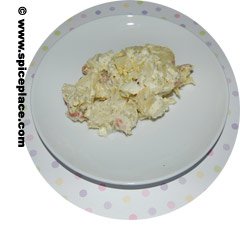 We enjoy having potato salad along with our summer barbecued foods like hamburgers, and chicken. Somehow the taste of potato salad blends with the barbecued foods. Occasionally we have found some prepared potato salad with a nice taste. But that’s hard to find as storage, preservatives, and mass production all are detrimental to the flavor.
We enjoy having potato salad along with our summer barbecued foods like hamburgers, and chicken. Somehow the taste of potato salad blends with the barbecued foods. Occasionally we have found some prepared potato salad with a nice taste. But that’s hard to find as storage, preservatives, and mass production all are detrimental to the flavor.
So we prefer, most of the time, to make our own potato salad. We know it’s fresh, limit the amount of salt we add, and enjoy knowing the potato salad was a result of our own efforts. We’ve never entered this recipe in a contest, but all of our friends rave over it when we serve the recipe at holiday weekend barbecues.
Easy Potato Salad Recipe
- 2 pounds of red skinned potatoes
- 2 eggs
- 3/4 cup light mayonnaise
- 2 tbsp dried cilantro
- 1/8 tsp white pepper
- 2 tbsp lemon juice
To make Easy Potato Salad
- Fill a large pot with water, and bring to a boil.
- Add the red skinned potatoes.
- Cook for 12 minutes, then add the 2 eggs in shell to make hard-boiled eggs.
- Cook for another 12 minutes. Drain, cool, then refrigerate the potatoes and eggs for 3 hours.
- Peel the potatoes if desired. Cut the potatoes into 1/2″ chunks and place in a large bowl.
- Peel the hard-boiled eggs, cut into 1/4″ slices, and then crumble the eggs over top of the potatoes.
- Combine the mayonnaise, cilantro, lemon juice, and white pepper in a Pyrex measuring cup.
- Mix a little dressing at a time into the potatoes. Keep adding more dressing until the potatoes are well coated with the mixture.
- Cover and refrigerate at least 1/2 hour. Mix and serve.
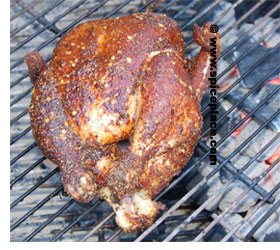 Often when we season foods for the grill we consider using spice blends like McCormicks Grill Mates and Durkee Grill Creations. While those are excellent seasonings, we like variety in our cooking and often wander off the beaten path and venture into our own seasoning wilderness. So yesterday, we came up with this recipe for Maryland Grilled Whole Chicken.
Often when we season foods for the grill we consider using spice blends like McCormicks Grill Mates and Durkee Grill Creations. While those are excellent seasonings, we like variety in our cooking and often wander off the beaten path and venture into our own seasoning wilderness. So yesterday, we came up with this recipe for Maryland Grilled Whole Chicken.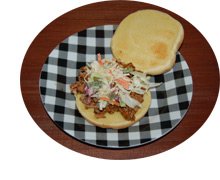 Today we felt like slow cooking on the barbecue, and decided to make a genuine Carolina Pork Loin. We chose a 3 pound pork loin for our roast — instead of the typical pork butt [pork shoulder] roast most typical of this recipe. Our choice of a pork loin over pork butt was mostly because of the lower fat in the pork loin. The pork butt will shred better, but as you can see below the pork loin made a great pulled pork sandwich. Chose the roast the suits your taste and diet. We lean toward the leaner cuts of meat.
Today we felt like slow cooking on the barbecue, and decided to make a genuine Carolina Pork Loin. We chose a 3 pound pork loin for our roast — instead of the typical pork butt [pork shoulder] roast most typical of this recipe. Our choice of a pork loin over pork butt was mostly because of the lower fat in the pork loin. The pork butt will shred better, but as you can see below the pork loin made a great pulled pork sandwich. Chose the roast the suits your taste and diet. We lean toward the leaner cuts of meat.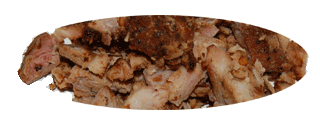 Chop the pork roast into 1/2″ to 3/4″ size chunks using a heavy meat cleaver. A cleaver is the best method of doing this task.
Chop the pork roast into 1/2″ to 3/4″ size chunks using a heavy meat cleaver. A cleaver is the best method of doing this task.
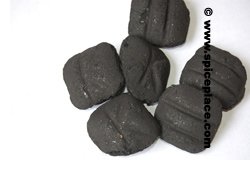 When asked what charcoal is, many folks would describe Kingsford charcoal or the knock offs of Kingsford. Kingsford is a fine quality charcoal, and is made with hardwoods, ground, then bound together and pressed into briquets. Kingsford’s origin comes from the Ford Motor Company, and the product was created to find a use for all of the scrap lumber from the production of Ford Automobiles. We use Kingsford all of the time, and don’t bother with the knock-offs as we find the knock-offs are inferior to Kingsford.
When asked what charcoal is, many folks would describe Kingsford charcoal or the knock offs of Kingsford. Kingsford is a fine quality charcoal, and is made with hardwoods, ground, then bound together and pressed into briquets. Kingsford’s origin comes from the Ford Motor Company, and the product was created to find a use for all of the scrap lumber from the production of Ford Automobiles. We use Kingsford all of the time, and don’t bother with the knock-offs as we find the knock-offs are inferior to Kingsford.
 We’ve been trying to perfect Jamaican Jerk Chicken and have come to realize that the secret is in preparation and planning. We bought a bunch of chicken breasts and chicken thighs, and decided to try making the Jamaican Jerk Chicken two ways. The first way was straight following the recipe on the package of
We’ve been trying to perfect Jamaican Jerk Chicken and have come to realize that the secret is in preparation and planning. We bought a bunch of chicken breasts and chicken thighs, and decided to try making the Jamaican Jerk Chicken two ways. The first way was straight following the recipe on the package of